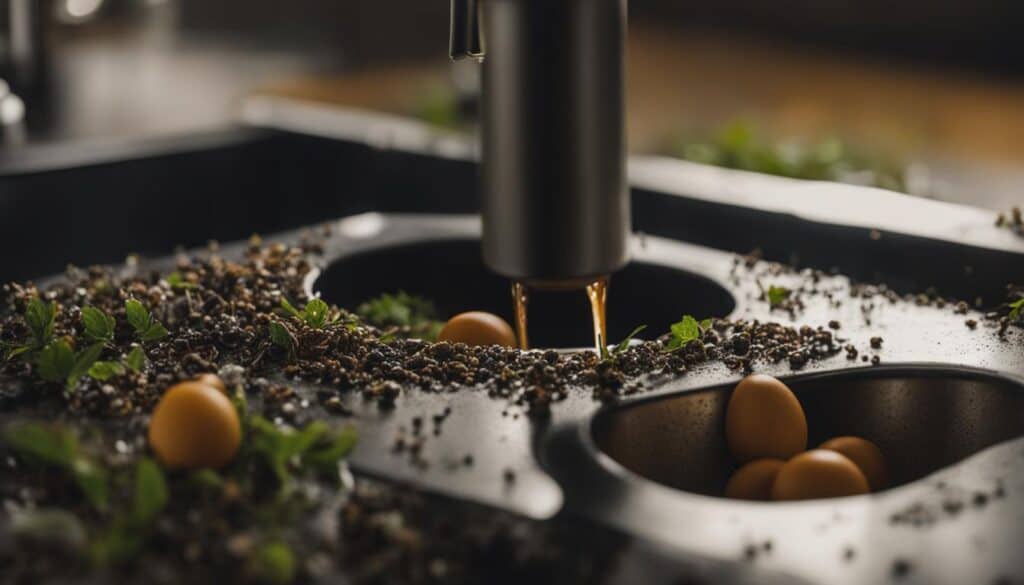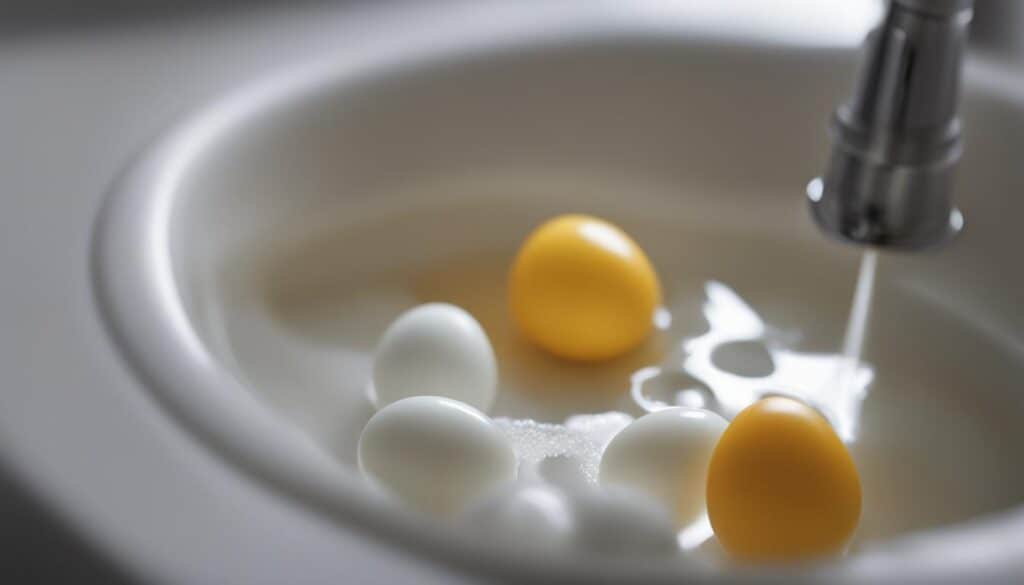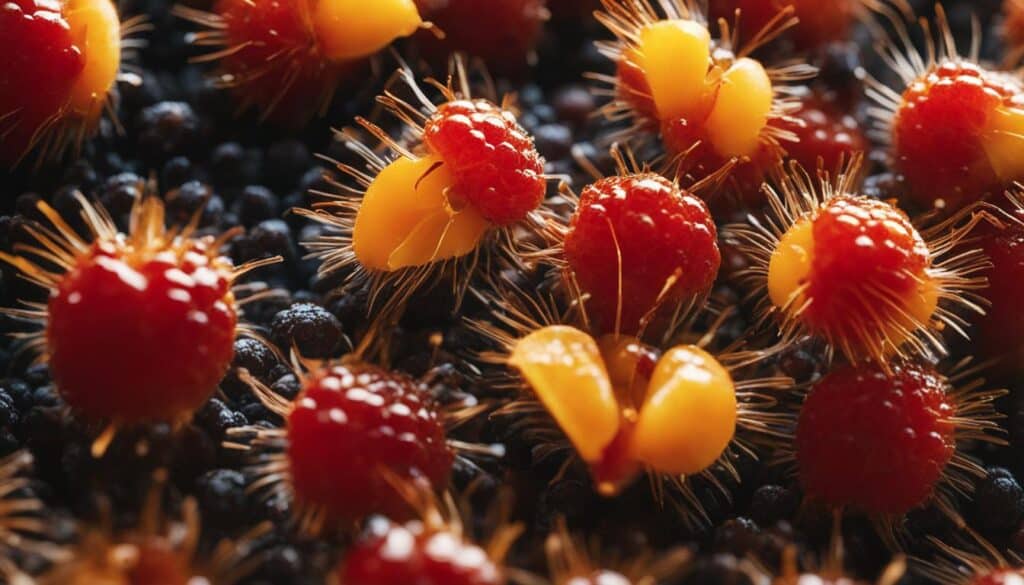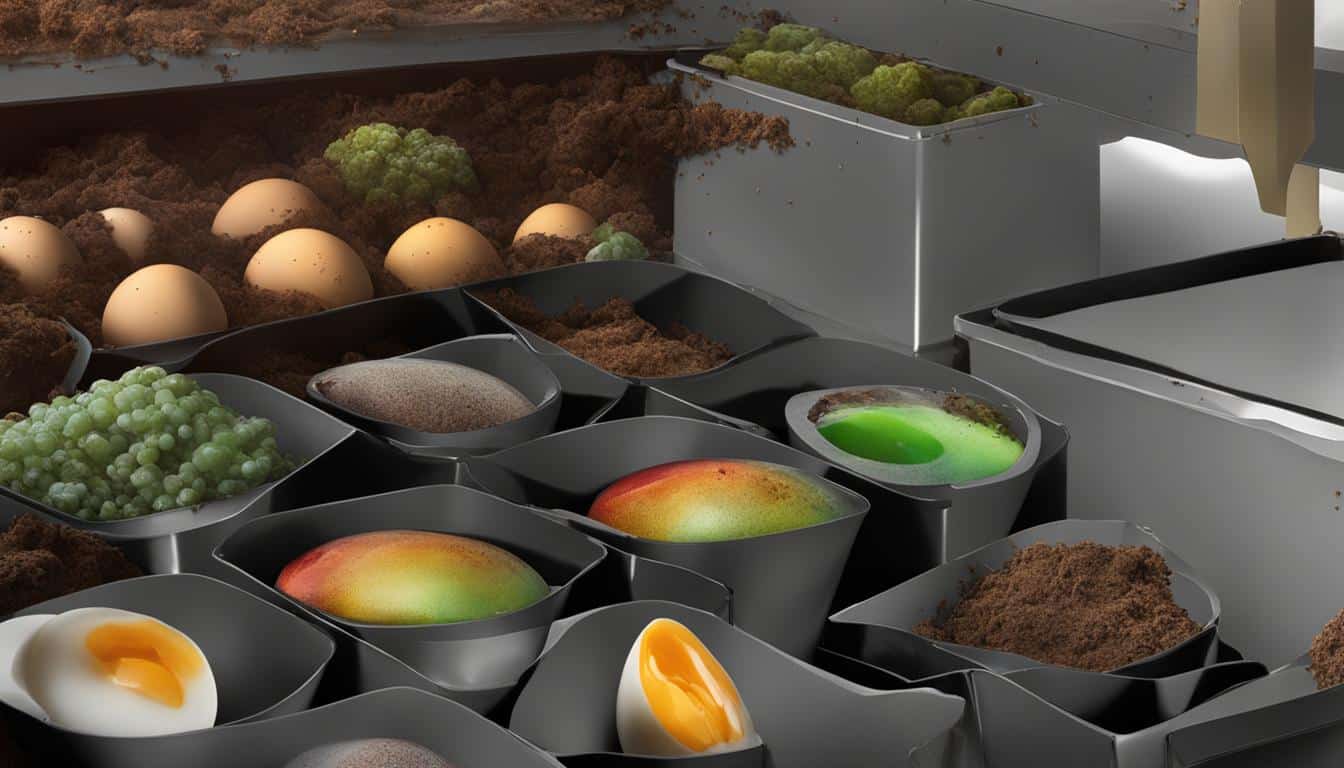Greetings! Today, I am going to dive into the fascinating world of fruit flies and uncover their secret egg-laying habits. Have you ever wondered where these pesky little insects choose to deposit their eggs? Well, you’re about to find out!
Fruit flies have a particular affinity for areas where decaying organic matter is present. These include ripe or rotting fruits and vegetables, garbage, and drains. When a female fruit fly is attracted to one of these locations, she will discreetly lay her eggs on the surface. You might find these tiny eggs in places like kitchen countertops, garbage bins, compost piles, and drains.
Now that we know where fruit flies lay their eggs let’s explore the intriguing life cycle of these insects.
Key Takeaways:
- Fruit flies lay their eggs in decaying organic matter such as ripe or rotting fruits and vegetables, garbage, and drains.
- Common locations for fruit fly eggs include kitchen countertops, garbage bins, compost piles, and drains.
- Understanding where fruit flies lay their eggs can help in eliminating and preventing infestations.
Stay tuned for more intriguing information about fruit flies and their intriguing habits!
The Life Cycle of Fruit Flies
The life cycle of a fruit fly consists of four stages: egg, larva, pupa, and adult. Fruit flies lay their eggs on the surface of ripe or decaying fruits, vegetables, and other organic matter. The eggs hatch into small, white larvae, which feed and develop within the food source. After a few days, the larvae pupate, forming a pupal case. Inside the pupal case, the adult fruit fly develops and eventually emerges. The entire life cycle from egg to adult can take as little as 7-10 days, depending on environmental conditions such as temperature and humidity.
| Stage | Description | Duration |
|---|---|---|
| Egg | The female fruit fly lays eggs on the surface of ripe or decaying fruits, vegetables, or organic matter. | Approximately 1-2 days |
| Larva | The eggs hatch into small, white larvae that feed and develop within the food source. | Approximately 4-6 days |
| Pupa | The larvae pupate, forming a pupal case where the adult fruit fly develops. | Approximately 3-5 days |
| Adult | The fully developed adult fruit fly emerges from the pupal case. | Approximately 1-2 days |
During the larval stage, the larvae feed on the decaying organic matter, breaking it down and speeding up the decomposition process. This is why fruit flies are commonly found in areas where there is ripe or rotting fruit, garbage, and drains. The warm and moist conditions created by the decaying matter provide an ideal environment for fruit fly eggs to hatch and the larvae to thrive.
Understanding the life cycle of fruit flies is essential in effectively controlling and preventing infestations. By targeting their breeding sites and interrupting their life cycle, you can keep fruit fly populations in check and minimize their impact on your home and daily life.
Preferred Breeding Sites for Fruit Flies
Fruit flies are known for their ability to reproduce quickly, making it essential to understand their preferred breeding sites in order to effectively combat infestations. These tiny pests are attracted to areas with decaying organic matter, providing them with the necessary nutrients and moisture for their eggs to develop. Here are some common breeding sites where fruit flies reproduce:
- Kitchen Countertops: Fruit flies are drawn to ripe or rotting fruits and vegetables left out on countertops. Even a small piece of produce can be an attractive breeding ground for these pests.
- Gabage Bins: Trash cans that contain food waste, especially fruits and vegetables, are ideal breeding sites for fruit flies. It is important to properly seal garbage bags and regularly empty the bins to prevent infestations.
- Compost Piles: Fruit flies are attracted to compost piles as they provide a rich source of decaying organic matter. If you have a compost bin, make sure it is properly maintained and turned regularly to prevent fruit fly breeding.
- Drains: Fruit flies can lay their eggs in the organic matter that accumulates in drains. Regularly cleaning and sanitizing kitchen and bathroom drains can help eliminate breeding sites.
These are just a few examples of the preferred breeding sites for fruit flies. It is important to be vigilant and address any potential breeding grounds in order to prevent infestations from occurring.
| Breeding Site | Description | Prevention Tips |
|---|---|---|
| Kitchen Countertops | Ripe or rotting fruits and vegetables left on countertops. | Store fruits and vegetables in the refrigerator, and clean countertops regularly. |
| Gabage Bins | Trash cans containing food waste, especially fruits and vegetables. | Properly seal garbage bags and regularly empty the bins. |
| Compost Piles | Compost bins with decaying organic matter. | Maintain the compost pile properly, turn it regularly, and avoid adding fruits and vegetables. |
| Drains | Organic matter that accumulates in kitchen and bathroom drains. | Regularly clean and sanitize drains to remove potential breeding sites. |
Understanding the preferred breeding sites for fruit flies is crucial in preventing infestations. By eliminating or reducing these breeding grounds, you can effectively control fruit fly populations in your home. Regular cleaning, proper storage of fruits and vegetables, and regular maintenance of drains and garbage bins are key steps in preventing fruit fly infestations.
It is important to note that fruit flies are attracted to sugary substances and odors, which is why they are commonly found in areas with spilled juices, overripe fruits, and fermenting liquids like wine or vinegar. Keeping your kitchen clean, taking out the garbage regularly, and addressing any damp or moist areas can go a long way in preventing fruit fly infestations.
Fruit Flies in the Kitchen

When it comes to fruit flies, the kitchen is often a prime breeding ground due to its abundance of food sources and moisture. These pesky insects are attracted to the smells and sugars found in ripe or decaying fruits and vegetables, making your kitchen an ideal place for them to lay their eggs. Fruit flies can deposit their tiny eggs on the surface of fruits and vegetables, as well as on moist areas such as countertops and sinks.
To effectively combat fruit flies in the kitchen, it is important to maintain cleanliness and eliminate potential breeding sites. Keep your kitchen clean and free of exposed food by storing fruits and vegetables properly in the refrigerator. Regularly empty trash cans and compost bins, as fruit flies are also attracted to the moisture and nutrients found in garbage. Additionally, it is essential to clean drains and kitchen surfaces regularly to remove any organic matter that may attract fruit flies.
By taking these preventive measures, you can significantly reduce the chances of a fruit fly infestation in your kitchen. Remember, a clean and well-maintained kitchen is the key to keeping these unwanted pests at bay.
Fruit Flies in the Kitchen
- Keep your kitchen clean and free of exposed food.
- Store fruits and vegetables properly in the refrigerator.
- Regularly empty trash cans and compost bins.
- Clean drains and kitchen surfaces regularly.
Fruit Flies in the Garbage and Recycling Area
When it comes to fruit fly breeding sites, the garbage and recycling area is a prime location. Fruit flies are attracted to decaying organic matter, making trash cans and recycling bins an ideal environment for them to lay their eggs. The surface of food waste, including fruits, vegetables, and other scraps, can become a breeding ground for fruit fly eggs. Additionally, the dampness and moisture found in these areas further support fruit fly reproduction.
To effectively prevent fruit fly infestations in the garbage and recycling area, it is essential to take certain measures. Properly sealing garbage bags can help minimize the attraction for fruit flies. Keeping trash cans and recycling bins clean and regularly emptying them will also make these areas less appealing to fruit flies. Additionally, maintaining good hygiene practices, such as cleaning spills promptly and ensuring a dry environment, can significantly reduce the presence of fruit flies.
Here is a table summarizing the key information about fruit fly breeding sites in the garbage and recycling area:
| Breeding Sites | Description |
|---|---|
| Food Waste | Surface of decaying fruits, vegetables, and other scraps |
| Trash Cans | Dampness and moisture support fruit fly reproduction |
| Recycling Bins | Same as trash cans, fruit flies can use the moisture as a breeding site |
By taking proactive measures in managing garbage and recycling areas, you can significantly reduce the presence of fruit flies and prevent infestations. Regular sanitation, proper waste disposal, and maintaining a dry environment are key to controlling fruit flies in these areas.
Fruit Flies in the Bathroom

Fruit flies are pesky insects that can also be found in bathrooms, taking advantage of the damp and moist environment. They are attracted to spilled liquids, organic matter in drains, and damp towels or sponges. These areas provide suitable conditions for fruit flies to lay their eggs and reproduce, leading to infestations if not addressed promptly.
To prevent fruit flies in the bathroom, it is essential to keep the area clean, dry, and free of any potential food or organic matter that may attract them. Regularly clean and sanitize sinks, drains, and countertops to remove any traces of food or spilled liquids. Ensure that towels and sponges are properly dried after use and do not provide a moist environment for fruit flies to thrive.
If you are dealing with a fruit fly infestation in the bathroom, there are several steps you can take to eliminate them. Start by identifying and removing any potential breeding sites, such as decaying organic matter in drains or wet towels. Consider using fruit fly traps or natural repellents, such as citrus sprays or essential oils, to deter and capture adult flies. Additionally, maintaining good ventilation in the bathroom can help reduce moisture levels and discourage fruit flies from settling in.
By implementing these preventive measures and taking prompt action, you can effectively control fruit fly infestations in your bathroom and maintain a clean and pest-free environment.
Prevention and Control of Fruit Fly Infestations
When it comes to preventing and controlling fruit fly infestations, understanding their breeding grounds and egg-laying habits is key. By targeting these areas and implementing effective control measures, you can significantly reduce fruit fly populations in your home.
Identifying Fruit Fly Breeding Grounds
Fruit flies are attracted to damp, fermenting organic matter, making certain areas of your home particularly attractive to them. Here are some common fruit fly breeding grounds that you should pay attention to:
- Kitchen: Fruit flies are often found in the kitchen, where they are drawn to ripe or decaying fruits and vegetables. They can also lay their eggs on moist surfaces like countertops and sinks.
- Garbage and Recycling Area: Fruit flies thrive in trash cans and recycling bins, as they find ample food sources in the decaying organic matter.
- Bathroom: Although less common, fruit flies can also infest bathrooms, especially around sinks and drains, where dampness and moisture create favorable conditions for breeding.
Control Measures to Implement
To prevent and control fruit fly infestations, consider the following control measures:
- Practice good sanitation: Clean up spilled liquids promptly and wipe down surfaces regularly to remove food residues that can attract fruit flies.
- Properly store fruits and vegetables: Keep ripe or decaying fruits and vegetables in the refrigerator, as fruit flies are less likely to lay their eggs on cold surfaces.
- Empty trash cans and compost bins regularly: Dispose of organic waste properly and ensure that garbage bags are tightly sealed to prevent fruit fly breeding.
- Clean drains and sinks: Fruit flies can lay their eggs in moist drains and sinks. Regularly clean and sanitize these areas to eliminate potential breeding sites.
- Use fruit fly traps: Vinegar traps, which can be made by placing apple cider vinegar in a container with a few drops of dish soap, can help capture adult fruit flies.
By implementing these prevention and control measures, you can effectively reduce fruit fly populations and minimize the risk of infestations. Remember to be consistent and thorough in your efforts to maintain a fruit fly-free environment in your home.
| Fruit Fly Breeding Grounds | Control Measures |
|---|---|
| Kitchen | – Clean countertops and sinks regularly – Store fruits and vegetables in the refrigerator |
| Garbage and Recycling Area | – Regularly empty and clean trash cans – Properly seal garbage bags |
| Bathroom | – Keep bathroom areas clean and dry – Fix any leaks or sources of moisture |
Remember, prevention is key when it comes to fruit flies. By taking proactive measures to eliminate their breeding grounds and implementing effective control strategies, you can keep your home free from these pesky insects.
Professional Pest Control for Fruit Flies
If you are dealing with a persistent or large-scale fruit fly infestation, it may be necessary to seek professional pest control services. Professionals have the knowledge, experience, and resources to effectively eliminate fruit flies and provide long-lasting solutions. They can identify the breeding sites, apply targeted treatments, and implement preventive measures to ensure the infestation does not recur.
Professional pest control companies have access to a range of effective insecticides and methods specifically designed to target fruit flies. They can safely and efficiently treat both indoor and outdoor areas, including kitchens, garbage and recycling areas, and bathrooms. By addressing the root cause of the infestation, professionals can effectively control and eliminate fruit fly problems.
In addition to treating the existing infestation, professional pest control services also focus on preventing future infestations. They can provide recommendations for eliminating potential breeding sites, improving sanitation practices, and implementing long-term preventive measures. By partnering with a professional pest control company, you can save time and effort while ensuring a thorough and effective solution to your fruit fly infestation.
Benefits of Professional Pest Control for Fruit Flies
- Expertise: Pest control professionals have in-depth knowledge of fruit fly behavior, breeding habits, and effective control methods.
- Customized Solutions: Professionals can tailor their treatment approach to the specific needs and extent of your fruit fly infestation.
- Long-lasting Results: Professional treatments are designed to provide long-term control and prevent future infestations.
- Reduced Health Risks: By eliminating fruit flies, professionals help minimize the risk of foodborne illnesses and bacterial contamination.
- Peace of Mind: With professional pest control, you can rest assured that your home is free from fruit fly infestations.
When choosing a professional pest control company, look for reputable service providers with experience in fruit fly control. Ensure they are licensed and certified, and inquire about their treatment methods and guarantees. By taking action and enlisting professional help, you can effectively control fruit fly infestations and maintain a pest-free environment in your home.
| Company | Services | Guarantee |
|---|---|---|
| Pest Control Pros | Expert fruit fly control | 90-day guarantee |
| Green Pest Solutions | Eco-friendly fruit fly control | Satisfaction guarantee |
| Orkin | Comprehensive pest control services | 100% satisfaction guarantee |
The Dangers and Risks of Fruit Flies

Fruit flies may seem harmless and annoying, but they can actually pose risks to human health. These tiny insects can carry bacteria and pathogens on their bodies, including E. coli, listeria, and salmonella. When fruit flies come into contact with food or food preparation surfaces, they can contaminate them with these harmful microorganisms. Consuming contaminated food can lead to foodborne illnesses and gastrointestinal infections.
To protect your health and the health of your family, it is important to take fruit fly infestations seriously and address them promptly. By understanding the potential dangers and risks associated with fruit flies, you can prioritize their elimination and prevent the spread of harmful bacteria in your home.
Fruit flies can carry bacteria and pathogens on their bodies, including E. coli, listeria, and salmonella.
Proper sanitation practices and hygiene are key to preventing fruit fly-borne diseases. This includes regularly cleaning up spilled liquids, properly storing fruits and vegetables in the refrigerator, and ensuring that kitchen surfaces and utensils are kept clean and free from fruit fly contamination. Additionally, eliminating their breeding and feeding sites, such as ripe or rotting fruits and vegetables, trash cans, and drains, can help reduce the risk of fruit fly infestations and the spread of bacteria.
| Fruit Fly-Borne Diseases | Source | Symptoms |
|---|---|---|
| E. coli | Contaminated food and surfaces | Diarrhea, abdominal pain, fever |
| Listeria | Contaminated food and surfaces | Fever, muscle aches, nausea, diarrhea |
| Salmonella | Contaminated food and surfaces | Diarrhea, fever, abdominal cramps, vomiting |
By being proactive in preventing and controlling fruit fly infestations, you can reduce the health risks associated with these pests. Implementing proper sanitation practices, seeking professional pest control assistance when necessary, and maintaining a clean and hygienic environment in your home will help protect you and your loved ones from fruit fly-borne diseases.
Homemade Remedies for Fruit Fly Control

Fruit flies can be a persistent nuisance in our homes, but there are several homemade remedies and DIY fruit fly traps that can help in controlling their infestations. These natural alternatives can be effective in reducing fruit fly populations and preventing their reproduction, without the use of harmful chemicals. Here are a few homemade remedies that you can try:
1. Apple Cider Vinegar Trap
Apple cider vinegar is highly attractive to fruit flies, making it an excellent ingredient for a fruit fly trap. Simply pour apple cider vinegar into a small container, such as a glass or jar, and cover it with plastic wrap. Secure the plastic wrap with a rubber band and poke a few small holes in it. Fruit flies will be drawn to the scent of the vinegar, enter the container through the holes, and get trapped inside.
2. Red Wine Trap
Similar to apple cider vinegar, red wine is also attractive to fruit flies. Fill a small glass with red wine and cover it with plastic wrap, securing it with a rubber band. Make a few small holes in the plastic wrap to allow the fruit flies to enter. The flies will be lured by the aroma of the wine and become trapped inside the glass.
3. Dish Soap Trap
A dish soap trap can be made using a mixture of dish soap and water. In a small bowl, mix a few drops of dish soap with water until it becomes sudsy. Place the bowl near areas where fruit flies are present, such as the kitchen or garbage area. The soap will break the surface tension of the liquid, causing the fruit flies to sink and drown when they come into contact with it.
These homemade remedies can be used in conjunction with other preventive measures, such as proper sanitation practices and eliminating breeding sites, to effectively control fruit fly infestations. It is important to note that while these remedies may help in reducing fruit fly populations, they may not completely eliminate the problem. If you are dealing with a persistent infestation, it is advisable to seek professional pest control assistance.
Conclusion
In conclusion, fruit fly infestations can be a nuisance in homes, but with the right knowledge and preventative measures, they can be effectively controlled. To prevent fruit fly infestations, it is important to maintain proper sanitation practices in your home. This includes regularly cleaning up spills, keeping your kitchen clean and free of exposed food, and properly sealing garbage and compost bins.
By eliminating potential breeding sites and food sources, you can greatly reduce the population of fruit flies in your home. Additionally, using homemade remedies such as vinegar traps or natural repellents like basil leaves can assist in fruit fly control. However, in cases of persistent or large-scale infestations, it may be necessary to seek professional pest control assistance.
Remember, taking prompt action is crucial in addressing fruit fly infestations. Not only can these pesky insects be a nuisance, but they can also pose health risks by carrying and spreading bacteria and pathogens. By implementing the tips and strategies discussed in this article, you can eliminate fruit fly problems and enjoy a pest-free environment in your home.
FAQ
Where do fruit flies lay their eggs?
Fruit flies lay their eggs in places where there is decaying organic matter, ripe or rotting fruits and vegetables, garbage, and drains.
What is the life cycle of a fruit fly?
The life cycle of a fruit fly consists of four stages: egg, larva, pupa, and adult. Fruit flies lay their eggs on the surface of ripe or decaying fruits, vegetables, and other organic matter.
What are the preferred breeding sites for fruit flies?
Fruit flies are attracted to moist, fermenting organic matter. Their preferred breeding sites include ripe or rotting fruits and vegetables, trash cans, recycling bins, compost piles, drains, and even damp mops or sponges.
Why are fruit flies commonly found in the kitchen?
The kitchen is a common area where fruit fly infestations occur due to the abundance of food sources and moisture. Fruit flies are attracted to the smells and sugars found in ripe or decaying fruits and vegetables.
Where can fruit flies be found in the garbage and recycling area?
Fruit flies are commonly found in garbage and recycling areas, as they are attracted to decaying organic matter. They can lay their eggs on the surface of food waste, including fruits, vegetables, and other food scraps.
Can fruit flies be found in the bathroom?
Although less common, fruit flies can be found in bathrooms. The damp and moist environment of bathrooms, especially around sinks and drains, can provide suitable conditions for fruit flies to lay their eggs and reproduce.
How can I prevent and control fruit fly infestations?
Effective prevention and control of fruit fly infestations involve eliminating or reducing their breeding and feeding sites. This includes regularly cleaning up spilled liquids, properly storing fruits and vegetables, regularly emptying trash cans and compost bins, and cleaning drains and kitchen surfaces.
Should I seek professional pest control for fruit flies?
If you are dealing with a persistent or large-scale fruit fly infestation, professional pest control may be necessary. Pest control professionals have the knowledge, experience, and resources to effectively eliminate fruit flies and provide long-lasting solutions.
What are the risks of fruit flies to human health?
Fruit flies can carry bacteria and pathogens on their bodies, including E. coli, listeria, and salmonella. When fruit flies come into contact with food or food preparation surfaces, they can contaminate them with these harmful microorganisms.
Are there any homemade remedies for fruit fly control?
Yes, there are several homemade remedies and DIY fruit fly traps that can help in controlling fruit fly infestations. These include using apple cider vinegar traps, red wine traps, or dish soap traps.
What is the conclusion of fruit fly control?
By understanding fruit fly breeding habits, implementing proper sanitation practices, and seeking professional pest control assistance when necessary, you can eliminate fruit fly problems and enjoy a pest-free environment in your home.





Leave a Reply